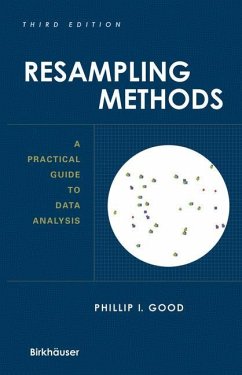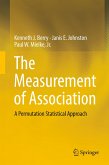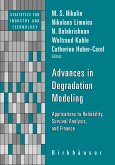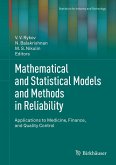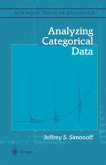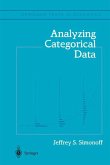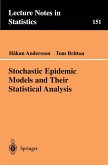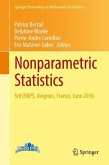"...the author has packaged an excellent and modern set of topics around the development and use of quantitative models.... If you need to learn about resampling, this book would be a good place to start." Technometrics (Review of the Second Edition)
This thoroughly revised and expanded third edition is a practical guide to data analysis using the bootstrap, cross-validation, and permutation tests. Only requiring minimal mathematics beyond algebra, the book provides a table-free introduction to data analysis utilizing numerous exercises, practical data sets, and freely available statistical shareware.
Topics and Features
- Practical presentation covers both the bootstrap and permutations along with the program code necessary to put them to work.
- Includes a systematic guide to selecting the correct procedure for a particular application.
- Detailed coverage of classification, estimation, experimental design, hypothesis testing, and modeling.
- Suitable for both classroom use and individual self-study.
New to the Third Edition
- Procedures are grouped by application; a prefatory chapter guides readers to the appropriate reading matter.
- Program listings and screen shots now accompany each resampling procedure.
- To simplify programming, code for readers to download and apply is posted at http://www.springeronline.com/0-8176-4386-9.
- Notation has been simplified and, where possible, eliminated.
- A glossary and answers to selected exercises are included.
With its accessible style and intuitive topic development, the book is an excellent basic resource for the power, simplicity, and versatility of resampling methods. It is an essential resource for statisticians, biostatisticians, statistical consultants, students, and research professionals in the biological, physical, and social sciences, engineering, and technology.
Hinweis: Dieser Artikel kann nur an eine deutsche Lieferadresse ausgeliefert werden.
This thoroughly revised and expanded third edition is a practical guide to data analysis using the bootstrap, cross-validation, and permutation tests. Only requiring minimal mathematics beyond algebra, the book provides a table-free introduction to data analysis utilizing numerous exercises, practical data sets, and freely available statistical shareware.
Topics and Features
- Practical presentation covers both the bootstrap and permutations along with the program code necessary to put them to work.
- Includes a systematic guide to selecting the correct procedure for a particular application.
- Detailed coverage of classification, estimation, experimental design, hypothesis testing, and modeling.
- Suitable for both classroom use and individual self-study.
New to the Third Edition
- Procedures are grouped by application; a prefatory chapter guides readers to the appropriate reading matter.
- Program listings and screen shots now accompany each resampling procedure.
- To simplify programming, code for readers to download and apply is posted at http://www.springeronline.com/0-8176-4386-9.
- Notation has been simplified and, where possible, eliminated.
- A glossary and answers to selected exercises are included.
With its accessible style and intuitive topic development, the book is an excellent basic resource for the power, simplicity, and versatility of resampling methods. It is an essential resource for statisticians, biostatisticians, statistical consultants, students, and research professionals in the biological, physical, and social sciences, engineering, and technology.
Hinweis: Dieser Artikel kann nur an eine deutsche Lieferadresse ausgeliefert werden.
"[The book] has a 309-item bibliography, a glossary, and author and subject indices.... [It] provides much greater depth on the methods [than other books on the same subject]. Software support is broad." Pharmaceutical Statistics
"I enjoyed this book. The style of writing suggests that statistics is fun and exploratory (which it often is). The reader is helped and encouraged to understand the problem (how the data were obtained) and how they might analyze it using resampling methods." The American Statistician (review of the second edition)
"...the author has packaged an excellent and modern set of topics around the development and use of quantitative models.... If you need to learn about resampling, this book would be a good place to start." Technometrics (review of the second edition)
"This book is what the title suggests, a practical guide to data analysis...helpful to the beginner...and a good resource...to an advanced user... The first few chapters provide a great pedagogical tool for creating in high school students an early interest in statistics. The book also proves to be a good resource for advanced topics with an extensive bibliography [and] provides in the Appendices C++, GAUSS, SAS, S-Plus and Stata codes for various procedures used in the book, along with resource material on resampling software." Technometrics (review of the first edition)
"Readers with a wide variety of backgrounds and interests should find this book illuminating and a valuable introduction." Short Book Reviews (Int'l Statistical Institute, review of the first edition)
"There is a list of 409 bibliographical references ranging from extremely theoretical to very applied... The appendices...contain advice for the ad hoc programmer, examples of code in various programming environments, as well as a guide to many resources for resampling software... More than 130 exercises are also included... This book has many very useful features for newcomers to applied statistics who will be able to learn a lot from it about the general principles of the business and about modern computer intensive methods." Mathematical Reviews (review of the first edition)
"Most introductory statistics books ignore or give little attention to resampling methods, and thus another generation learns the less than optimal methods of statistical analysis. The author attempts to remedy this situation by writing an introductory text that focuses on resampling methods, and he does it well." Ron. C. Fryxell, Albion College (review of the first edition)
"...The wealth of the bibliography covers a wide range of disciplines." Dr. Dimitris Karlis, Athens University of Economics (review of the first edition)
"I enjoyed this book. The style of writing suggests that statistics is fun and exploratory (which it often is). The reader is helped and encouraged to understand the problem (how the data were obtained) and how they might analyze it using resampling methods." The American Statistician (review of the second edition)
"...the author has packaged an excellent and modern set of topics around the development and use of quantitative models.... If you need to learn about resampling, this book would be a good place to start." Technometrics (review of the second edition)
"This book is what the title suggests, a practical guide to data analysis...helpful to the beginner...and a good resource...to an advanced user... The first few chapters provide a great pedagogical tool for creating in high school students an early interest in statistics. The book also proves to be a good resource for advanced topics with an extensive bibliography [and] provides in the Appendices C++, GAUSS, SAS, S-Plus and Stata codes for various procedures used in the book, along with resource material on resampling software." Technometrics (review of the first edition)
"Readers with a wide variety of backgrounds and interests should find this book illuminating and a valuable introduction." Short Book Reviews (Int'l Statistical Institute, review of the first edition)
"There is a list of 409 bibliographical references ranging from extremely theoretical to very applied... The appendices...contain advice for the ad hoc programmer, examples of code in various programming environments, as well as a guide to many resources for resampling software... More than 130 exercises are also included... This book has many very useful features for newcomers to applied statistics who will be able to learn a lot from it about the general principles of the business and about modern computer intensive methods." Mathematical Reviews (review of the first edition)
"Most introductory statistics books ignore or give little attention to resampling methods, and thus another generation learns the less than optimal methods of statistical analysis. The author attempts to remedy this situation by writing an introductory text that focuses on resampling methods, and he does it well." Ron. C. Fryxell, Albion College (review of the first edition)
"...The wealth of the bibliography covers a wide range of disciplines." Dr. Dimitris Karlis, Athens University of Economics (review of the first edition)
"This book provides an introduction to topics ranging from bootstrapping to regression trees, using computer code from a myriad of programs every step of the way. Topics covered include methods for one and two populations, power, experimental design, categorical data, multivariate methods, model building, and decision trees. The third edition restructures these categories into groupings by application rather than by statistical method, making the book far more user-friendly for the practicing statistician.
Good's passion for making statistics not only palatable but enjoyable for the reader is evident in his enthusiastic tone, his excellent motivating examples, and his clear and nontechnical discussions of the methodologies. At the beginning of the text, a section titled 'Which Chapter Should I Read?' helps the reader determine where to find the information desired. Within the chapters, the reader is encouraged to explore data rather than simply plug it into formulas, and at the end of the chapter, a section titled 'To Learn More' provides an extensive list of references. Problems at the end of the chapter make the book useful as a textbook." -JASA (review of the third edition)
"[The book] has a 309-item bibliography, a glossary, and author and subject indices.... [It] provides much greater depth on the methods [than other books on the same subject]. Software support is broad." -Pharmaceutical Statistics
"I enjoyed this book. The style of writing suggests that statistics is fun and exploratory (which it often is). The reader is helped and encouraged to understand the problem (how the data were obtained) and how they might analyze it using resampling methods." -The American Statistician (review of the second edition)
"...the author has packaged an excellent and modern set of topics around the development and use of quantitative models.... If you need to learn aboutresampling, this book would be a good place to start." -Technometrics (review of the second edition)
"This book is what the title suggests, a practical guide to data analysis...helpful to the beginner...and a good resource...to an advanced user... The first few chapters provide a great pedagogical tool for creating in high school students an early interest in statistics. The book also proves to be a good resource for advanced topics with an extensive bibliography [and] provides in the Appendices C++, GAUSS, SAS, S-Plus and Stata codes for various procedures used in the book, along with resource material on resampling software." -Technometrics (review of the first edition)
"Readers with a wide variety of backgrounds and interests should find this book illuminating and a valuable introduction." -Short Book Reviews (Int'l Statistical Institute, review of the first edition)
"There is a list of 409 bibliographical references ranging from extremely theoretical to very applied... The appendices...contain advice for the ad hoc programmer, examples of code in various programming environments, as well as a guide to many resources for resampling software... More than 130 exercises are also included... This book has many very useful features for newcomers to applied statistics who will be able to learn a lot from it about the general principles of the business and about modern computer intensive methods." -Mathematical Reviews (review of the first edition)
"Most introductory statistics books ignore or give little attention to resampling methods, and thus another generation learns the less than optimal methods of statistical analysis. The author attempts to remedy this situation by writing an introductory text that focuses on resampling methods, and he does it well." -Ron. C. Fryxell, Albion College (review of the first edition)
"...The wealthof the bibliography covers a wide range of disciplines." -Dr. Dimitris Karlis, Athens University of Economics (review of the first edition)
Good's passion for making statistics not only palatable but enjoyable for the reader is evident in his enthusiastic tone, his excellent motivating examples, and his clear and nontechnical discussions of the methodologies. At the beginning of the text, a section titled 'Which Chapter Should I Read?' helps the reader determine where to find the information desired. Within the chapters, the reader is encouraged to explore data rather than simply plug it into formulas, and at the end of the chapter, a section titled 'To Learn More' provides an extensive list of references. Problems at the end of the chapter make the book useful as a textbook." -JASA (review of the third edition)
"[The book] has a 309-item bibliography, a glossary, and author and subject indices.... [It] provides much greater depth on the methods [than other books on the same subject]. Software support is broad." -Pharmaceutical Statistics
"I enjoyed this book. The style of writing suggests that statistics is fun and exploratory (which it often is). The reader is helped and encouraged to understand the problem (how the data were obtained) and how they might analyze it using resampling methods." -The American Statistician (review of the second edition)
"...the author has packaged an excellent and modern set of topics around the development and use of quantitative models.... If you need to learn aboutresampling, this book would be a good place to start." -Technometrics (review of the second edition)
"This book is what the title suggests, a practical guide to data analysis...helpful to the beginner...and a good resource...to an advanced user... The first few chapters provide a great pedagogical tool for creating in high school students an early interest in statistics. The book also proves to be a good resource for advanced topics with an extensive bibliography [and] provides in the Appendices C++, GAUSS, SAS, S-Plus and Stata codes for various procedures used in the book, along with resource material on resampling software." -Technometrics (review of the first edition)
"Readers with a wide variety of backgrounds and interests should find this book illuminating and a valuable introduction." -Short Book Reviews (Int'l Statistical Institute, review of the first edition)
"There is a list of 409 bibliographical references ranging from extremely theoretical to very applied... The appendices...contain advice for the ad hoc programmer, examples of code in various programming environments, as well as a guide to many resources for resampling software... More than 130 exercises are also included... This book has many very useful features for newcomers to applied statistics who will be able to learn a lot from it about the general principles of the business and about modern computer intensive methods." -Mathematical Reviews (review of the first edition)
"Most introductory statistics books ignore or give little attention to resampling methods, and thus another generation learns the less than optimal methods of statistical analysis. The author attempts to remedy this situation by writing an introductory text that focuses on resampling methods, and he does it well." -Ron. C. Fryxell, Albion College (review of the first edition)
"...The wealthof the bibliography covers a wide range of disciplines." -Dr. Dimitris Karlis, Athens University of Economics (review of the first edition)

